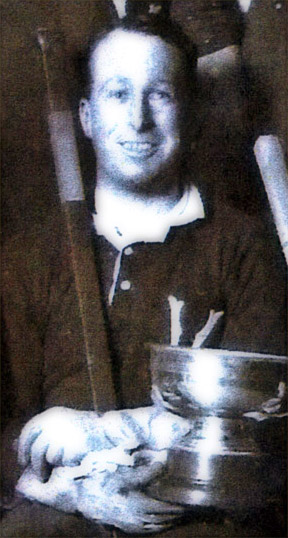CAREER SUMMARY
Birth
1893
St Kilda Melbourne Australia
Death
19 April 1960 (67)
Brighton Melbourne Australia
Clubs
VIHA Melburnian
Goodall Cups
1922
Olympics
Nil
World Championships
Nil
Life Memberships
Nil
Namesake of Goodall Cup
Fourth National Men's Skating Champion, 1914
Captain of Victoria, 1922
President, Victorian ice hockey association
Prime mover and first president of national ice hockey association
BORN IN 1893 AT ST. KILDA, John Goodall was the son of Charles and Ada. He lost his father at a young age and followed in the footsteps of his grandfather, a founder of the Australian Stock Exchange. He attended Melbourne Grammar School and began playing for the Melburnian Ice Hockey Club at 15, where most members were Melbourne Grammar students. Goodall donated the trophy for Australia's first interstate series in 1909, now known as the Goodall Cup, the most prestigious prize in Australian ice hockey. The Goodall Cup has been contested annually to this day by the top players in Australia and is the third oldest national ice hockey trophy still being contested.
Goodall's first interstate game was at 17 in 1910 with the second Victorian State team. He was the fourth NISAA National Men's Skating Champion in 1914. In 1916, he inherited a share of his grandfather's estate and became a successful stock and share broker, working with the company his grandfather had established on Queen St.
During the Great War, Victoria lost many foundation players in the league. Goodall, who became president of the VIHA, led the rebuilding of the decimated game. He became the first president of the National Ice Hockey and Speed Skating Council in 1923, the forerunner of the national associations for both sports. He married and retired as a player, briefly returning for the farewell series for the legendary Jim Kendall in 1925. He was committed to setting the sport on a national footing and presenting the Goodall Cup at interstate tournaments.
In 1930, he resumed his role as head of the VIHA, presiding over the reorganization of the clubs during the Great Depression, which aimed to give young players better opportunities to develop. He introduced the first true, age-delimited junior ice hockey leagues in Australia.
Goodall was involved in various other activities outside of ice hockey, such as yachting with the Royal Yacht Club of Victoria and racing cars, including the inaugural Australian Grand Prix. In addition, his family connections in North America helped position Australian ice sports at the forefront of global developments.
1. John Goodall’s wife Kathleen (Fanning) presented the inaugural Gower Cup for senior women's interstate competition. The soprano gave away her stage career when they married but returned to public performance during the Great Depression, playing right through the heyday of theatre — over 3,500 performances — then breaking into radio.
2. After a five-year absence, Goodall returned to head the VIHA in 1930 following the death of its president, Peter Ross Sutherland. In the depths of the Great Depression, he presided over the re-organisation of the VIHA clubs, aiming to give "young players a better chance to improve themselves". In the 1931 season, the association dropped St Kilda and restructured Hawthorn, Brighton and Essendon to include junior teams for the first time in history. Seniors played on Monday nights, and juniors on Thursdays. Goodall created the first inter-club juniors and inter-school competition that year. These were the first true, age-delimited junior ice hockey leagues in Australia.
3. Melbourne Grammar won the inaugural VIHA Junior Public Schools under-16 ice hockey competition. The league included Scotch College and Wesley College, with games played at the Glaciarium on Saturday mornings. Although schoolboys had competed in team races in Victoria since before 1924, the Victorian speed skating championships under the control of the same association were simultaneously redefined in 1931, enabling boys and girls to compete in under-sixteen and under-eighteen junior age divisions.
4. A well-known member of the Royal Automobile Club of Victoria, Goodall owned a rare 1923 Aston Martin Sports in the mid-1920s. He began racing the following year, and four years later, on 31 March 1928, he entered his 1923 Aston Martin-Anzani in the 100 Miles Road Race at Phillip Island. Today, this race is known as the inaugural Australian Grand Prix. The Aston Martin remained in the Goodall family for over fifty years. John and Kathleen had children, including a son named John, who had a son named John.
5. Family connections with great uncles in North America helped John Goodall to position Australian ice sports at the forefront of developments occurring worldwide, not so long after entrepreneurs built the first wave of engineered ice rinks in the world in the 1890s. Capt Charles Miner Goodall and his brothers, Harry and Samuel, had also inherited considerable wealth and influence. Both were well-established on the east and west coasts, in San Francisco, New York and elsewhere, long before skating and ice hockey became mainstream sports.
6. From 1877 to 1916, the vessels of their new Pacific Steamship Company plied the Pacific all along the West Coast, between California, British Columbia, Washington, and Alaska, and it was mainly these centres that influenced Australian ice sports. The Goodall shipping line and its related coal and railway companies was a pioneering arm of a loosely defined trade alliance sailing trans-Pacific routes during the formative years of organised ice sports worldwide. Incidentally, but quite literally, it connected ice sports in America and Canada, then straddled the Pacific to Australia.
Ross Carpenter, 'Goodall, John Edwin (1893 - )', Legends of Australian Ice, Melbourne, Australia, http://icelegendsaustralia.com/legends-2/bio-goodall.html, accessed online .


